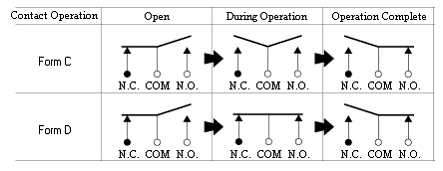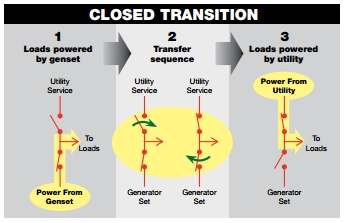Home › Electrical Engineering Forum › General Discussion › Closed Transition Transfer Switch
- This topic has 0 replies, 1 voice, and was last updated 11 years, 1 month ago by
admin.
-
AuthorPosts
-
2013/10/04 at 9:52 am #11096
admin
KeymasterLast time, Nasir taught us about the working and advantages of an Open Transition Transfer switch, now it’s all about the working and advantages of a Closed Transition Transfer Switch.
A Closed Transition transfer switch also operates on the same principle as that of an open transition switch, except the fact that the delay which is incorporated in the open transition switch has been eliminated and hence the contacts occur without any delay in the time.
Working of a Closed Transition Transfer Switch
The process occurs such that if the power is being supplied from the primary power source, and it’s time for the contact to break due to a break in the power, then first the contact will be made with the backup power supply.
i.e. the alternate source from which the load has to be transferred is closed and the afterwards the contact will open from the main power source.
In this way there is a brief moment in which both the contacts are closed, so that there is no such time in which the power supply is interrupted.
This process can be shown as follows:
The main advantage of this type of transfer switch is that a continuous power supply is available all the time and if there are any such devices which are sensitive to power supplies, then these types of loads are least affected by such power interruptions.
Conditions for a Closed Transition Transfer Sequence
Two conditions are very necessary for a closed transition transfer sequence to operate safely:
- The moment when both the sources are closed, they should be synchronized at that moment, i.e. there should be no difference of phase in between them.
- The time of synchronized of both the contacts should be no more than a few milliseconds to avoid any disturbance in the power supply.
To fulfill these conditions, certain additional attachments are required with the transfer switch for the best results.
Advantages of a Closed Transition Transfer Switch
- Keeping its extensive use and the best results for un interrupted power supply in mind, these switch serve as the best remedy for sensitive equipment which otherwise could get badly affected by the power interruptions due to the switching time between contacts.
- These are the least expensive transfer switches which are able to provide an uninterrupted, continuous supply of power.
- Due to accurate synchronization between the two voltages, a very efficient supply of power transfer occurs.
- These are the best solution for soft loads to prevent any damage to them.
Classification of Closed Transition Transfer Switches
Closed Transition Transfer switches can be classified in a variety of categories, depending upon their synchronization action and the time in which both the contacts are closed.
- Active Closed Transition Transfer Switch.
- Passive Closed Transition Transfer Switch.
- Soft Loading.
In an active switch, a special automatic synchronization switch is used to control the synchronization so that an efficient power transfer can occur.
On the other hand, in a passive switch a synchronization check relay is incorporated, which only allows the two contacts to close when the two sources are in synchronization.
Like an Active switch, soft loading mode of the transfer switch also uses a synchronization switch to monitor the synchronization process.
This was a brief, but easy to understand introduction of the closed type transfer switch.
In the next tutorial I am going to give you an even detailed explanation on a soft loading transfer switch, which finds its extensive uses in everyday applications. So stay tuned and upgrade your knowledge to know and learn better. Thanks.
Nasir.
-
AuthorPosts
- You must be logged in to reply to this topic.

